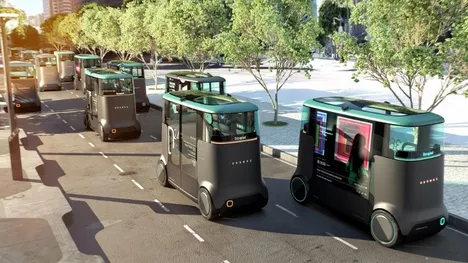
problem statement
Increasing urbanization yields continuously growing demand for mobility in cities. Therefore, innovative solutions are necessary to satisfy this need sustainably. In the recent past, various novel offers in the low capacitive spectrum were presented, e.g. bicycle and e-scooter rental or ride sharing apps. However, those approaches can’t match the growing mobility demand of future cities due to capacity restrictions related to their fundamental design. Amongst the established systems, rail-based transportation systems, such as suburban- and underground railway, pose the best option to provide high capacitive transportation. Nevertheless, downsides of these public transport systems are, amongst others, high construction costs and insufficient efficiency apart from peak hours. Thus, they have to be subsidized in most cases. Furthermore, this form of public transport completely lacks personal privacy for the customers. The desire for comfort, short journey times and privacy can nowadays solely be satisfied by private cars. Though, the road network is often overloaded and the restricted space within citied does not allow to raise its capacity.
In cooperation with Dromos, the potentials and challenges of a high capacitive public transportation system in the form of small autonomous vehicles on dedicated infrastructure are to be investigated. The focus of this project lies on the classification of the described system within urban mobility, the analysis of strengths and weaknesses of the new mobility concept as well as necessary infrastructure and applied operating strategies.
project goal
The goal of this project is to develop, introduce and analyze a new public transportation system. To provide a high capacitive system for mobility, congestion has to be prevented. Hence, the question regarding optimal infrastructure has to be solved. How to design the basic topology of the network to gain the best possible service? Which features does the network need to obviate bottlenecks? What kind of redundancy is necessary to deal with failures?
Further questions cover optimal operating strategy. What is the optimal policy for on demand routing, rebalancing and dispatching? Since the vehicles are powered electrically they have to be charged sufficiently to fulfil their task before returning to a charging station. Besides considering charging in the operational policy, charging stations have to be placed optimally in the network.
Furthermore, this high capacitive means of transport is to be categorized within the range of urban mobility options. When is it advisable for a customer to use this system? Under which conditions is this system the right solution for a city to get rid off its traffic problems? Which cases are profitable for the maintainer? Apart from these questions, effects like a potential gain of safety and anticipated decrease of noise pollution are to be analyzed from the perspective of society.
realization
To answer the aforesaid questions, a microscopic simulation of the system is utilized on one hand, on the other hand the questions are transformed into mathematical formulations. By means of simulation effects and interactions of different solution approaches can be tested. In this manner, different, e.g. AI based, optimization algorithms, network topologies and operation policies can be compared objectively and subsequently be improved in accordance with the results. For this purpose, synthetical and generalizable situations are simulated as well as algorithms are tested with a realistic example – the city of Munich.
